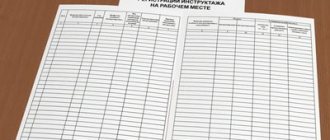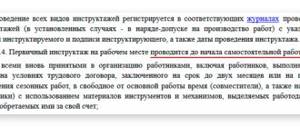The employer is obliged to ensure the safety of its employees. Routine safety training is a means of informing workers about how to avoid injuries at work.
Labor legislation requires maintaining a special journal with a schedule of such briefings.
Dear readers! Our articles talk about typical ways to resolve legal issues, but each case is unique.
If you want to find out how to solve your particular problem, contact the online consultant on the right or call the free consultation numbers:
Basic Concepts
Occupational safety is a set of measures to ensure the safety of employees of an organization.
It includes:
- actions to ensure fire safety;
- sanitary maintenance of the enterprise;
- safety when using electrical equipment;
- measures to improve working conditions.
Safety precautions are an integral part of labor protection. It consists of measures aimed at reducing occupational injuries .
Safety consists not only of maintaining the good condition of industrial buildings and equipment, but also of instructing personnel on safe work practices.
At large enterprises, this is done by a labor protection specialist. Read more in this article.
Legislation
The main document regulating employee health issues is the Labor Code. Article 212 clearly states the employer's obligation to notify its employees of possible health risks . The same article states that the employer is obliged not to allow employees to work who have not undergone safety training.
Article 225 of the Labor Code of the Russian Federation states that every employee of an organization, including managers, must know safety rules.
If a person is just starting a job, the manager is obliged to educate him about these rules. The employee must listen to all safety briefings and then sign in the logbook.
Journals are the most convenient form of reporting , therefore they are used everywhere. They are filled in manually. Requirements for keeping logs can be found in GOST 12.0.004-2015.
Logging
Keeping labor safety logs is necessary for reporting to supervisory authorities. This should be handled by a separate specialist within the organization . The log is useful not only for the state inspector, but also for the employer, since it allows you to monitor the progress of workers listening to instructions.
There are different types of magazines, they all have a standard appearance, but have different purposes.
Any organization should maintain the following types:
- Introductory briefing registration log - it records those who attended the very first safety briefing, which is mandatory for employees of all levels;
- On the registration of briefings at the workplace - these briefings are carried out by responsible work managers right before they begin, as a result of which an oral survey is carried out, and a note is made in the log about the employee’s access to work;
- labor protection instructions
- Accounting for safety training – it records the results of intermediate training and control of knowledge on safety;
- On accounting of accidents;
- For issuing instructions to workers;
- On fire safety;
- Accounting for fire safety equipment;
- Inspection records – the document contains data on all inspections of working conditions, as well as violations identified during them. This journal must be maintained by both individual entrepreneurs and legal entities;
- Taking into account briefings on the rules of working on electrical equipment;
- Taking into account the first and second stages of control over labor protection and working conditions.
Sample of a completed journal for recording instructions:
Here you can log on the accounting instructions.
What are the retention periods for logs?
Depending on the purpose, OT magazines have different shelf life, for example:
- Registrations of occupational diseases cannot be destroyed; they must be stored indefinitely.
- Storage of logs that reflect information about briefings is ensured for at least 10 years.
- Documents that prescribe the imposition of administrative penalties and fines are stored for 3 years.
The storage periods for logs can be regulated by the administrative document of the enterprise.
Filling procedure
Previously, GOST was specified, according to which it is recommended to keep all logs. But it is only a recommendation . There is no uniform standard for recording occupational safety measures. What is important here is not the form, but the content of the report. Nevertheless, several informal rules for record keeping can be identified.
There is a standard form for the safety log. This is an A4 size book , a sample of which can be found on the Internet. Such books are sold in stationery stores. It is better to immediately take them with a reserve, because you can make mistakes during the first attempts to fill out the journal.
The pages of the magazine must be stitched and numbered if it was printed on a printer. It should begin with a title page, which indicates the full name of the organization, as well as the date the document was maintained. Numbering is done in black ink on each page in the right corner.
Correctly filling out training logs
Full name, position, signature_______.” The journal is signed by the person authorized to keep this journal; sealed with the seal of the organization.
We place the seal so that its imprint is both on the sticker and on the cover/sheet of the magazine to which the ends of the lacing are glued.
See picture. Let us dwell in more detail on some aspects of filling out logs related to the registration of briefings.
Journal form: recommended - Appendix 4 “GOST 12.0.004-90. Interstate standard. System of occupational safety standards.
Organization of occupational safety training.
General provisions." Who fills out the log (conducts instructions)? Occupational safety specialist or employer, or employee assigned this function by order of the organization.
Information to fill out.
Responsibility
Some documents are of increased importance and therefore require closer attention to storage and execution. Firmware and numbering of documentation is not a whim at all, but protection from making illegal changes by tearing out/adding pages and other unauthorized actions.
Is it necessary to flash magazines in a private office? The answer is yes. It doesn’t matter at all what form of ownership the organization has, an audit can easily come to an ordinary individual entrepreneur, because the law is the same for everyone.
How to lace occupational safety magazines
The employer is obliged to ensure the safety of its employees. Routine safety training is a means of informing workers about how to avoid injuries at work.
Labor legislation requires maintaining a special journal with a schedule of such briefings.
Dear readers! Our articles talk about typical ways to resolve legal issues, but each case is unique.
If you want to find out how to solve your particular problem, contact the online consultant on the right or call the free consultation numbers: Occupational safety – a set of measures to ensure the safety of the organization’s employees. It includes:
- safety when using electrical equipment;
- sanitary maintenance of the enterprise;
- measures to improve working conditions.
- actions to ensure fire safety;
Safety precautions are an integral part of labor protection.
Maintaining a health and safety log
The employer is obliged to ensure the safety of its employees. Routine safety training is a means of informing workers about how to avoid injuries at work.
Labor legislation requires maintaining a special journal with a schedule of such briefings.
Basic concepts Labor protection is a set of measures to ensure the safety of employees of an organization. It includes:
- measures to improve working conditions.
- actions to ensure fire safety;
- sanitary maintenance of the enterprise;
- safety when using electrical equipment;
Safety precautions are an integral part of labor protection.
Hello, in this article we will try to answer the question "".
You can also consult with lawyers online for free directly on the website. This allows you to check the correct performance of these functions and fairly deal with cases of worker injuries. Every new employee is required to go through the training procedure and sign in the registration log.
No exceptions are made either for workers with many years of experience or for those with a higher specialized education.
The issuance of labor safety instructions is carried out by a separate personnel employee - an occupational safety specialist (engineer). He can familiarize workers with the rules of safe work activity both orally and in writing.
She expected to see two beds screwed to the floor, or a bunk bed and a built-in closet.
List of occupational safety magazines
Labor protection is a mandatory condition for the functioning of an enterprise.
For proper organization within the company, special journals are maintained.
articles The key obligation of the employer is to ensure the safety of the employee. The framework notes that there is a specific list of responsibilities in terms of maintaining documents necessary to inform personnel about basic regulatory requirements.
Therefore, each company must have a personally developed system and rational procedure in relation to record keeping.
The occupational safety journal (hereinafter referred to as OSH) serves as a fundamental document. It is used to record the briefings carried out. Within the organization, it is necessary to ensure the development of a registration procedure, as well as appoint a responsible person.
An important role is played by compliance with storage periods, which are determined by the order papers. Occupational Safety and Health
Correctly filling out training logs
07/13/2015 29 825Topics: ,The work of occupational safety specialists involves filling out a large number of document forms, such as, for example, magazines.
Despite the variety of regulatory legal acts regulating the availability of certain journals, it is possible to identify general principles for maintaining these forms of documents. numbered.
You can number the pages or sheets of the magazine; numbering the sheets will be less labor-intensive; laced.
The ends of the lacing material should be released on the cover of the magazine or on its last page and secured with a sticker so that the ends of the lacing remain visible. To avoid inconvenience when using a laced magazine, the length of the extended ends of the lacing must be at least 5 cm.
drawing; signed by the person responsible for maintaining it.
Destroying the Myth about Keeping Occupational Safety and Health Logs!
Pages:Select Feed Chat Author Services Training SOUTH Search Headings:Select OCCUPATIONAL HEALTH FIRE SAFETY INDUSTRIAL SAFETY ELECTRICAL SAFETY ENVIRONMENTAL SAFETY Civil Defense and Emergency Situations OCCUPATIONAL HEALTH QUESTION/ANSWER Educational program LABOR CODE VIDEO RUBRIC DOWNLOAD FILE NEWS NPA 12/25/2015 Greetings, dear friends! Surely many of the security specialists there do “this same thing”, namely, they sew together and number logs for registering introductory briefings, logs for registering instructions at the workplace (hereinafter referred to as occupational safety logs).
How to flash a logbook?
When working with documentation, sooner or later you are faced with the need to conduct. It is good if this knowledge is not obtained during the next inspection of some authorized bodies.
Firmware is an important element in office work, which is better not to be ignored, so as not to “get fined.”
If the document is stitched incorrectly, then in the future it will be problematic to prove that there was no substitution of information. This publication describes how to stitch and number a magazine correctly.
Some documents are of increased importance and therefore require closer attention to storage and execution.
Firmware and numbering of documentation is not a whim at all, but protection from making illegal changes by tearing out/adding pages and other unauthorized actions. Is it necessary to stitch magazines in a private office? The answer is yes. Not at all
How to flash a labor safety magazine sample
When working with documentation, sooner or later you are faced with the need to keep logs. It would be good if this knowledge was not obtained during the next inspection of some authorized bodies.
Firmware is an important element in office work, which is better not to be ignored, so as not to “get fined.”
If the document is stitched incorrectly, then in the future it will be problematic to prove that there was no substitution of information. This publication describes how to stitch and number a magazine correctly.
Some documents are of increased importance and therefore require closer attention to storage and execution.
The answer is yes.
We recommend reading: Agreement on sliding doors
No. 1/29). You can flash documents using the following tools:
- Stapler;
- Threads;
- Special equipment.
Accounting for information and reference documents Documents can be received by the organization by mail, fax, e-mail, telegraph, or by courier delivery.
225
Is it necessary to flash occupational safety magazines?
Author of the publication Subscribe publication:
(1.00) ( 1) 2 797 August 2021 at 17:18 Similar topics: Federal legislation does not contain such a requirement. The requirement is contained in some cross-industry/industry rules. For example, the Interindustry Rules for Occupational Safety and Health in Road Transport require stitching, numbering and sealing a workplace briefing logbook.
The rules on labor protection during the operation of electrical installations provide for stitching work logs according to work orders and orders and logs for testing knowledge of the rules of work in electrical installations for electric power organizations.
The requirement for the need to flash logs can be established by the employer’s local regulations on record keeping.
Thus, guided
Numbering of occupational safety magazines
. To begin with, there are several legal acts that regulate the procedure for filing documents:— Methodological explanations on the procedure for filling out certain forms of documents used for state registration of a legal entity, approved by order of the Ministry of the Russian Federation for Taxes and Duties dated April 18, 2003.
N BG-3-09/198;— clause 2.6.22 of section 2.6.
Source: https://em-an.ru/kak-shnurovat-zhurnaly-po-ohrane-truda-70519/
Numbering
If at least one sheet is missing from the log, this will immediately prompt the inspection body to think about official forgery at the enterprise. If the sheets were torn out, it means that some information was hidden, and then they will figure out who benefits from this and why. If the inspector definitely wants to punish the company for something, then unlaced documents will become an excellent “clue” in his activities.
You can number a book manually; in this case, it is the sheets, not the pages, that are numbered. The cover is not a sheet; Arabic numerals are usually placed in the lower right corner. If an error was made during manual numbering, you can correct the number with a pen and put next to it the signature of an official, for example a secretary, who is responsible for filing journals at the enterprise.
The modern market is oversaturated with goods; you can easily buy a beautifully numbered magazine right away. This is, without a doubt, convenient, because writing down numbers from one to one hundred is not the most exciting activity.
How to make holes?
You can make holes in a thin magazine or notebook with an awl, and gradually, step by step, page by page, pierce all the sheets. But if you have to deal with a multi-page copy, then they usually take a drill to help. It’s especially fascinating to watch how deftly the fragile girl accountant can handle the tool. And yet, when resorting to such heavy artillery, it is better to enlist male support.
To make your magazine look neat, do not pierce the cover, even if you really want to. The holes should be made as close to the spine (binding) as possible, then when opening the pages the threads will be practically invisible and they will not take up the useful area of the graph.
There are usually two holes, the distance between them is 6-10 centimeters. The holes are located approximately in the middle of the book.
Once the holes are made, the thread is inserted into a large needle and pulled through the holes. Both tails of thread should remain at the back of the magazine (between the last sheet and the back cover).
How to properly flash a labor safety magazine – Product labeling
When working with documentation, sooner or later you are faced with the need to keep logs. It would be good if this knowledge was not obtained during the next inspection of some authorized bodies.
Firmware is an important element in office work, which is better not to be ignored, so as not to “get fined.” If the document is stitched incorrectly, then in the future it will be problematic to prove that there was no substitution of information.
This publication describes how to stitch and number a magazine correctly.
Responsibility
Some documents are of increased importance and therefore require closer attention to storage and execution. Firmware and numbering of documentation is not a whim at all, but protection from making illegal changes by tearing out/adding pages and other unauthorized actions.
Is it necessary to flash magazines in a private office? The answer is yes. It doesn’t matter at all what form of ownership the organization has, an audit can easily come to an ordinary individual entrepreneur, because the law is the same for everyone.
When hiring a secretary or clerk, it is better to immediately clarify whether the candidate knows how to bind books and how he does it? If difficulties arise in answering this question, keep in mind: this applicant will not become a reliable partner, because the skill of firmware is no less important than the ability to write letters correctly or quickly type texts on a computer using the “blind ten-finger method.” And the good news is that this knowledge can be easily obtained once you have dealt with this issue.
In some structures, for example the security forces, the internal audit service always conducts an audit with particular passion, and first of all looks at whether the logs are properly formatted; they even check the lacing of the personnel notes!
All cash registers must be stitched first; everything related to finance is always the focus of control services. You should flash a book of complaints, a book of orders, and journals for notes on incoming/outgoing correspondence and other things.
Some journals are kept at enterprises for years; in these cases, it happens that the firmware thread helps the book simply not fall apart into its component parts due to old age.
How to stitch and number a magazine: step-by-step instructions
In fact, it is difficult to flash only your first document. After all, you don’t know where to start and how to properly stitch a magazine, or how to approach it in general. But working with subsequent documents will be an ordinary routine manipulation and nothing more.
How to flash a magazine? A sample can be seen in the photo below; a visual aid always works better than thousands of written words.
Numbering
If at least one sheet is missing from the log, this will immediately prompt the inspection body to think about official forgery at the enterprise.
If the sheets were torn out, it means that some information was hidden, and then they will figure out who benefits from this and why.
If the inspector definitely wants to punish the company for something, then unlaced documents will become an excellent “clue” in his activities.
The modern market is oversaturated with goods; you can easily buy a beautifully numbered magazine right away. This is, without a doubt, convenient, because writing down numbers from one to one hundred is not the most exciting activity.
Thread for firmware
An ordinary thread, like the one we sew on buttons and use in everyday life, is not suitable for work. If you take a thin sample, then over time the thread may break, and then you will have to stitch the magazine again, and this is far from a matter of minutes.
Most often, the clerk has in his arsenal a nylon thread, which is so strong that it is simply impossible to tear it with bare hands; it will definitely keep all the sheets together, even if the magazine accidentally falls.
How to make holes?
You can make holes in a thin magazine or notebook with an awl, and gradually, step by step, page by page, pierce all the sheets.
But if you have to deal with a multi-page copy, then they usually take a drill to help. It’s especially fascinating to watch how deftly the fragile girl accountant can handle the tool.
And yet, when resorting to such heavy artillery, it is better to enlist male support.
To make your magazine look neat, do not pierce the cover, even if you really want to. The holes should be made as close to the spine (binding) as possible, then when opening the pages the threads will be practically invisible and they will not take up the useful area of the graph.
There are usually two holes, the distance between them is 6-10 centimeters. The holes are located approximately in the middle of the book.
Once the holes are made, the thread is inserted into a large needle and pulled through the holes. Both tails of thread should remain at the back of the magazine (between the last sheet and the back cover).
Thread length
You also need to immediately figure out how long to cut the thread, both of its “tails” will have to remain free by about 15 centimeters, but it is better to act with a reserve, the extra millimeters can always be trimmed. The ends are needed so that a control sheet with the number of numbered pages can be glued on top of them.
Source: https://markirovka-znak.ru/kak-pravilno-proshit-zhurnal-po-ohrane-truda/
Checklist
The whole point of flashing magazines is to use a kind of homemade “seal” to forever fix the number of sheets that should be present in a given document under any circumstances.
We will need a cut piece of sheet, approximately 10*10 cm, on it we need to write by hand or print on a computer the following text: “In this magazine, “...” is numbered and laced. pages. The head of the enterprise must put his resolution on a square of paper, and the date of the operation is also indicated.
The thread is tied into a knot, and the ends remain free; the control sheet is glued using PVA to the knot itself and part of the threads. After the glue has dried, the manager puts a stamp on the control sheet so that it extends beyond its edges and the mark is present on the cover itself. This is the elementary scheme used to protect against attacks on the integrity of logs.
How to properly stitch documents with threads in 2, 3 and 4 holes: diagram, photo and video instructions
» Business organization » Registration » Office work » How to hem documents with threads for 2, 3 and 4 holes, as well as on the corner
Documents are stapled to ensure their integrity. Sequential numbering, as well as fastening the sheets with lace or thread, completely solve this problem.
Sometimes lacing is necessary according to the rules established by the organization, sometimes - according to the law. In this article we will look at how to properly flash documents in office work.
What documents need to be stapled?
In office work, documentation is most often stapled in order to transfer it to the archive, or when submitting it to a bank and other financial institutions. Also, document firmware is required when submitting reports to extra-budgetary funds and the Federal Tax Service. The document must not only be stitched, but also numbered. Papers are sewn together either with thread or tape, or using special machines.
The following types of documentation are subject to firmware:
- orders (both general and personal);
- staffing schedule;
- reports (for example, expense report);
- invoices;
- acts of completed work;
- cash book;
- statements.
It is also necessary to stitch documentation sheets when submitting an application for participation in a tender and in other cases.
— how to stitch things together before putting them into the archives:
Regulatory acts
The regulatory framework that today regulates the procedure for flashing documentation is very broad, however, most of the regulations have not been updated for a long time.
Thus, the main act that regulates the process of firmware documentation is the order of the Ministry of the Russian Federation for Taxes and Duties dated April 18, 2003, containing general instructions for filling out certain types of papers, including their firmware.
In addition to this document, the following regulations can be distinguished:
- GOST R 51141-98 “Office management and archiving. Terms and Definitions".
- Order of the Federal Tax Service of January 25, 2012 N ММВ-7-6/25. According to this order, the mandatory binding of documentation when submitting documents for registration of an organization or individual entrepreneur is canceled, however, the Federal Tax Service still prefers to accept stitched sheets.
- how to file things correctly:
Firmware documentation in some areas of activity is regulated by separate regulations of the organizations responsible for the area. Thus, firmware in the banking sector is regulated by the Instruction of the Central Bank of the Russian Federation “On office work in the Central Bank of the Russian Federation.”
Requirements for government agencies
The requirements for submitting documentation to government agencies differ from the requirements for documents when submitting, for example, to an archive. So, in order to submit papers to the court or tax office, you must follow the rules below:
- documents must be fastened in 3 holes;
- the distance between punctures should not exceed 3 cm;
- the paper is sewn together with thread or thin twine;
- paper measuring 3x5 cm is glued to the last page, on which a certification signature and seal are placed.
Special requirements apply to accounting reports, and the knot on the last page must be sealed with tissue paper.
How to flash documents correctly
Documents can be stitched with thread, lace or ribbon. This process must be approached responsibly, because if the firmware is of poor quality or weak, then the papers can be easily separated, which should not be allowed, because they are stitched so that it is impossible to put another document on them or lose part of it.
Moreover, if you are stitching papers for submission to government agencies, then incorrectly completed firmware can lead to the fact that the Federal Tax Service, extra-budgetary funds or the court simply refuse to accept them.
In 2 punctures
Firmware with 2 holes is very simple. Holes can be made either with a needle or with a hole punch. Of course, it's easier to pass thread, ribbon or string through the holes made with a hole punch.
The punctures should be on the left edge of the sheet (like a regular book) approximately 1-2 cm from it. After you pierce the paper, you need to pass the thread through the hole several times and tie the ends of the thread with a knot on the last page.
, which shows how documents are sewn together with threads through 2 holes:
In the upper right corner of each sheet you need to put the page number.
After this, the stitched documentation must be secured by gluing 3x5 cm paper onto the ends of the thread so that the ends peek out from under it. The paper is marked “Stitched and numbered” and the number of pages is also indicated. Afterwards, depending on where the papers will be provided, details such as the official’s signature, seal, and date are placed on the paper.
For 3 holes
Things are somewhat more complicated with stitching with three punctures, especially if you immediately pierce the sheets with a thread and a needle, rather than using a hole punch. To sew three holes on paper, follow the step-by-step instructions below with the diagram:
- Make the first puncture with a needle and thread on the back of the document being stitched in the middle of the sheet
- The second puncture with a needle is made on the front side of the document
- The next puncture should be made from the back of the third hole
- In the next step, we pass the needle and thread through the first hole - in the middle of the document on the front side
- Then you should tighten the threads so that they tightly pull the stitched sheets together and tie a knot as shown in the photo
clearly explains how to sew documents with 3 holes:
For 4 holes
This type of firmware is done only for documents that have a special status of importance.
To sew documentation into 4 holes, follow the following diagram and step-by-step instructions:
If the document being stapled contains many sheets, then you can pre-prepare four holes using a hole punch, drill or a special machine.
- You should start threading from the back side of the second hole from the edge.
- Next, the thread is threaded into the hole that is closest to the edge and the previously passed hole.
- Then we thread the thread again in the same way as in the first step.
- Next - from the front side to the next hole
- In the extreme puncture on the back side
- From the front side of the hole that we passed in the fourth step
- At the same time, we try to pull the thread so that it tightly compresses the sheets of documents
- All that remains is to tie the thread in a knot
- Trim excess length of thread ends
If the documents have been stitched correctly, all that remains is to number the sheets and stick a piece of paper on top of the bundle with the inscription “Stitched, numbered and sealed by ______ ( _____________ ) sheets” and put down the necessary details of the certifier (position, signature and full name).
— how to sew a case with 4 holes:
To the corner
Some papers may be corner bound, i.e. in the upper left corner. To do this, you need to make one or two holes in the corner and pass the thread through them several times.
— an example of stitching documents through a corner:
A sheet of paper, as in other cases, is glued to a knot of thread, and the details necessary for certification are placed on it.
How to number sheets
In most cases, numbering sheets when stitching does not cause difficulties, however, it is necessary to take into account some nuances:
- most often page numbers are written in Arabic numerals in ascending order;
- The sheet number is indicated at the top right. The number should not overlap the contents of the sheet;
- if there are applications, then they must also be numbered (continuous numbering is used);
- if letters with envelopes are attached to the documentation, then first of all the number is placed on the envelope, and then only on the sheets of the letter;
- if you number a case in which there are several volumes, then each of them is numbered separately;
- If it is necessary to number a sheet of a non-standard format, the number is also placed in the upper right corner. If the sheet extends beyond the document, it is folded and filed in the general manner;
- if the sheet contains several scans of small fragments (for example, checks), then it is recommended to create an inventory for the sheet and attach it to the documentation package, numbering it in the general order.
How to certify a bound document
After stitching and numbering of sheets, the documentation package must be certified. To certify it, paper is glued to the thread knot on the back side so as to leave the very ends of the thread free.
On the paper you must indicate the number of sheets (both in numbers and in words). If the bound document contains torn or damaged pages, this can also be indicated on the certification paper.
Next, it indicates the name, position and signature of the person who stitched the sheets or certified them (for example, a manager). A seal is placed on top of the paper so that its imprint is on both the certification paper and the last sheet.
You can download the sample “Stitched, numbered and sealed” in Word - HERE.
Useful tips
- Even the most ordinary student notebook can become a journal.
- Having sifted through information on how to flash a magazine, you may not always come across the following useful advice. Watch the tension; the stitching must be done loosely enough, otherwise the lace/thread will cut into the holes and tear the pages, or the book will not be able to be opened completely. A tightly bound journal does not allow for writing in the center of the spread.
- You can also find the required standard form on the Internet, print it out, punch it with a hole punch, sew it, and stick on a “control.”
- It is advisable to attach the control sheet with a glue stick: PVA takes a long time to dry, and moisture often blurs the signature and seal put by the manager in a hurry.
- There are situations when it is still necessary to make some changes to the log. For example, due to an unfortunate oversight or irresponsibility of an official, incorrect data was entered, or there is no registration information at all, in which case it is sometimes necessary to rewrite the log completely.
How to flash a logbook?
When working with documentation, sooner or later you are faced with the need to keep logs. It would be good if this knowledge was not obtained during the next inspection of some authorized bodies.
Firmware is an important element in office work, which is better not to be ignored, so as not to “get fined.” If the document is stitched incorrectly, then in the future it will be problematic to prove that there was no substitution of information.
This publication describes how to stitch and number a magazine correctly.
Checklist
The whole point of flashing magazines is to use a kind of homemade “seal” to forever fix the number of sheets that should be present in a given document under any circumstances.
We will need a cut piece of sheet, approximately 10*10 cm, on it we need to write by hand or print on a computer the following text: “In this magazine, “...” is numbered and laced. pages. The head of the enterprise must put his resolution on a square of paper, and the date of the operation is also indicated.
The thread is tied into a knot, and the ends remain free; the control sheet is glued using PVA to the knot itself and part of the threads. After the glue has dried, the manager puts a stamp on the control sheet so that it extends beyond its edges and the mark is present on the cover itself. This is the elementary scheme used to protect against attacks on the integrity of logs.
Useful tips
- Even the most ordinary student notebook can become a journal.
- Having sifted through information on how to flash a magazine, you may not always come across the following useful advice.
Watch the tension; the stitching must be done loosely enough, otherwise the lace/thread will cut into the holes and tear the pages, or the book will not be able to be opened completely. A tightly bound journal does not allow for writing in the center of the spread. - You can also find the required standard form on the Internet, print it out, punch it with a hole punch, sew it, and stick on a “control.”
- It is advisable to attach the control sheet with a glue stick: PVA takes a long time to dry, and moisture often blurs the signature and seal put by the manager in a hurry.
- There are situations when it is still necessary to make some changes to the log. For example, due to an unfortunate oversight or irresponsibility of an official, incorrect data was entered, or there is no registration information at all, in which case it is sometimes necessary to rewrite the log completely.
By the way, now there are a lot of portals on the Internet that can offer you to purchase any sample for little money and in a short time. The advantage of such a purchase is that the magazines will already come to you with holes for thread or even already completely stitched, and you will not need to think about how to stitch the magazine yourself.
Engineers for the protection of life and health of workers are usually interested in how to flash a labor safety log, but there is no special wisdom here - all these documents are laced according to the same principle.
By the way, the occupational safety journal is one of those that the employer must “groom and cherish”, because if something happens to an employee at work, the first thing the regulatory authorities will ask about the book is where these same employees read the safety rules under their signature.
Information to the personnel officer
But the book of registration of work books and inserts in them must not only be stitched, but sealed with a wax seal or sealed. The standard scheme of how to flash a journal to enter information about work books will not work here.
Some results
Let us repeat the basic rules stated above:
- Before work, carefully study the instructions on how to flash the magazine.
- Decide on a “piercing” tool.
- Do not pierce the cover (only the sheets themselves).
- Do not make holes far from the cover - the magazine will be inconvenient to open.
- The thread must be strong.
- Do not miscalculate the length of the thread, so as not to redo everything again.
- Number the magazine.
- Paste a control sheet, which will indicate the number of pages to be stitched and the date of stitching.
- Seal it.
We hope that after reading the article you have no questions about how to flash the logbook and similar documents.
Source: https://FB.ru/article/290370/kak-proshivat-jurnal-ucheta
Where to buy magazines?
By the way, now there are a lot of portals on the Internet that can offer you to purchase any sample for little money and in a short time. The advantage of such a purchase is that the magazines will already come to you with holes for thread or even already completely stitched, and you will not need to think about how to stitch the magazine yourself.
Engineers for the protection of life and health of workers are usually interested in how to flash a labor safety log, but there is no special wisdom here - all these documents are laced according to the same principle. By the way, the occupational safety journal is one of those that the employer must “groom and cherish”, because if something happens to an employee at work, the first thing the regulatory authorities will ask about the book is where these same employees read the safety rules under their signature.
Correctly filling out training logs
To conduct induction training you will also need to have:
- Introductory briefing program on labor protection, Instructions for conducting introductory briefing on labor protection.
As a rule, an organization maintains one log of induction training, but: Information to fill out.
- A list of labor safety instructions in force in your organization; Instruction programs; Labor safety instructions.
upon the introduction of new or amended legislative and other regulatory legal acts containing labor protection requirements, as well as labor protection instructions; when changing technological processes, replacing or upgrading equipment, devices, tools and other factors affecting labor safety; when employees violate labor safety requirements, if these violations create a real threat of serious consequences (industrial accident, accident, etc.)
What are the basic rules for maintaining documentation for office work: rules for firmware, numbering, what journals and accounting books are needed?
The third is internal information and reference documentation:
- internal correspondence (reports, official, explanatory notes);
- other documents (protocols, plans, acts, reports, etc.)
Accounting for information and reference documents Documents can be received by the organization by mail, fax, e-mail, telegraph, or by courier delivery.
Work with incoming documents is structured according to the following scheme:
- reception;
- sorting;
- management review;
- direction to performers.
Situation: Which orders relate to orders for personnel, and which - to orders for the main activity? Orders for personnel should include orders that document labor relations - hiring, transfer, relocation, dismissal, vacations, business trips, etc.
Some results
Let us repeat the basic rules stated above:
- Before work, carefully study the instructions on how to flash the magazine.
- Decide on a “piercing” tool.
- Do not pierce the cover (only the sheets themselves).
- Do not make holes far from the cover - the magazine will be inconvenient to open.
- The thread must be strong.
- Do not miscalculate the length of the thread, so as not to redo everything again.
- Number the magazine.
- Paste a control sheet, which will indicate the number of pages to be stitched and the date of stitching.
- Seal it.
We hope that after reading the article you have no questions about how to flash the logbook and similar documents.








